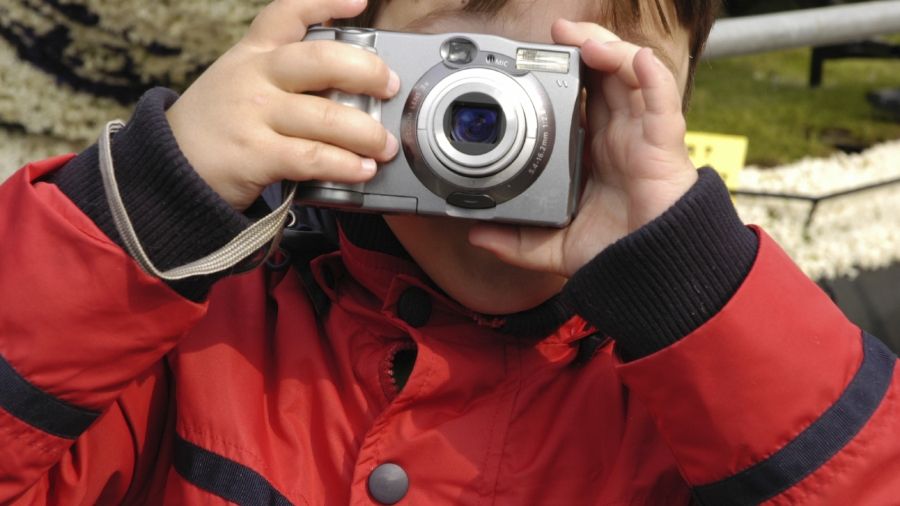
Here at the Harley School—an independent day school in Rochester, New York, that serves students in preschool through Grade 12—we work to create graduates who are "thoughtful and involved global citizens.” To help our students on their journey toward global citizenship, we developed curricula for our Grade One classroom that introduced children to the science of living things. But we found that while the children were acquiring factual knowledge in our program, they were not developing personal connections with the outdoor environment. We decided to work together as a team—two classroom teachers and one retired environmental educator—to design a new program that would more meaningfully connect children to nature, and that's how our Kids Afield project was born.
Using Photography to Engage Children
We decided to use photography as a centerpiece of the new program. Photography emerged as the medium of choice because it:
- encourages "hybrid thinking" that blends technology and natural elements;
- empowers children to make personal connections and choices through the camera’s lens;
- provides material, in the form of photos, for sharing in the classroom or with the wider world;
- provides a level of responsibility not often given young children by putting the care of cameras into their hands;
- introduces an aesthetic component to STEM; and
- provides record-keeping capabilities for inquiry-based learning.

An important goal of our program was to empower children with decision making. For this reason, in-class discussion always preceded our camera field work and the direction was set by the children's interest in conjunction with larger classroom goals. We prompted their thinking with open-ended questions that related to ongoing curricula, such as, "How can we use photos to understand what is happening outside right now in the trees, the creek, or the lawn?," or "What area would be a good place to hang a bird feeder?"
When the focus of the science curriculum shifted to geology, we talked about where we might find rocks on our school grounds. The discussion encouraged the children to think about the school campus through a new window, and prompted the students to use photography to help them look for and document rocks around the school. We hoped the children would develop a new understanding that rocks are a ubiquitous part of many environments that they'd never noticed before. What surprised us was the excitement with which the children sought out, found, and photographed this part of the natural world. The level of student engagement was tremendous and far greater than what we'd seen when students learned from photos in books.
Technology Tools Help Tell Our Stories
The next step was finding a way for the students to share their photos with family and friends. We discovered VoiceThread, an online tool to present photos and other files, and decided to use it because it allows for:
- sharing different types of media (including photos, audio files, presentations, and videos), which upload easily;
- commenting on materials via text, microphone, webcam, and smart phone;
- using the program via any computer, tablet, or smartphone because VoiceThreads are not stored on your device; and
- maintaining whatever level of privacy is desired: materials may be kept totally private or opened up to the entire world.
The students worked in teams of two to create a VoiceThread from their own photos. As the work can cover the entire school year, it becomes a strong visual record of seasonal changes over time. Click here for an example of a VoiceThread created by our students.
VoiceThread's strength is in the presentation of visual information and the ability to allow voice or text commentary to highlight, support, or question information. For children as young as five or six, it is both empowering and challenging for them to take ownership of their work in this manner. The following examples (a verbatim transcription of students' comments related to their photos) show the wide range of typical responses at this age level:

"I like this picture because it has flowers in it and it's white and my mom likes white and that's probably why I took this picture."

"I took this picture because it changed a lot from the winter and it's red and has lots of leaves on it."

" I like taking pictures because I never took one and I like that."
The camera-nature connection combines children's intrinsic enjoyment of exploring outdoors with their attraction to technology. As teachers, we have a unique opportunity given the increasingly "user-friendly" format of technology to facilitate children's exploration of the natural world in a way never imagined a generation ago. Moreover, their personal records of what they feel is important to record becomes a foundation upon which we can help them develop the communication skills that will take their understanding to a deeper level.
How You Can Use VoiceThreads
A VoiceThread license is required to use the site. A single educator account, which is what we use, has an annual fee of $79.00 (or a monthly fee of $15.00). At this level, you have access to 50 secure student accounts; the ability to view, edit, and delete student work; a custom web address; and 10 GB of class storage, plus an additional 1 GB per student. Site licenses for entire institutions or organizations are also available.
From our experience, we think it's best to begin by delivering the basic instruction about how to use the program on a large screen, and be ready to revisit the procedures as needed. Students can either work in small groups or pairs, or you can make a whole-class VoiceThread. The whole-class option has the advantage of group processing and reflection. Also, this will work in a classroom where only one computer is available. If students are working together in pairs or small groups, we've found that it works best to make their partnerships permanent, so they continue to work together on their VoiceThread for the length of the project. To make it manageable for the students, set small goals. For example, have teams aim to make one comment about one picture at a time. And, finally, if you have the means to scan drawings, remember that this a way that you can include student writing in your VoiceThreads.
We are now ending our second year using VoiceThread as a tool for sharing our work, and we will continue using it next year. In the fall, we plan to introduce a parent component early in the year so families can get involved. Additionally, now that we have a partner kindergarten in a Rochester City school taking photos with the same focus, we plan to share the work classroom-to-classroom with VoiceThread. To facilitate this effort, we created a slideshare "How to Use VoiceThread."
VoiceThread has nudged us toward new ways of communicating every year we've used it. While some might wish to keep technology away from the dirt, bugs, and explorations they recall from their own childhood outdoor adventures, we have discovered it can be a powerful way to enhance children's fascination with the natural world. Through the camera lens, children can focus on small, previously unknown mini-worlds and later revisit their discoveries through digital tools. Of course, not every outdoor exploration needs to include technology, but our experiences have shown it is a lost opportunity if technology is restricted to indoor learning.
About the Authors
Robin Long is a retired environmental educator in Rochester, New York, who taught enviornmental science in middle school. Marilyn Fenster is an early childhood educator, teaching first grade at the Harley School. They have collaborated on the Kids Afield project since 2012. Read more about the Kids Afield on their blog.